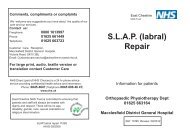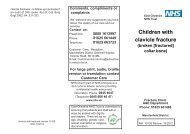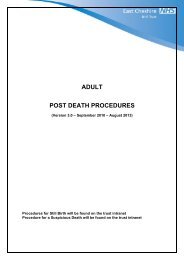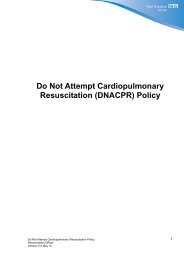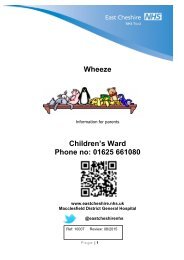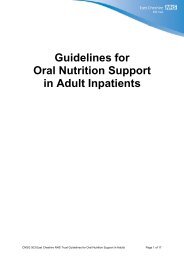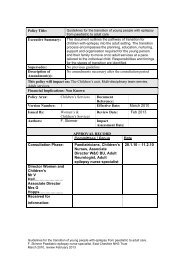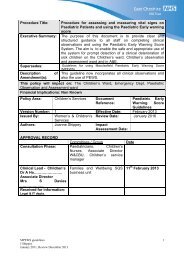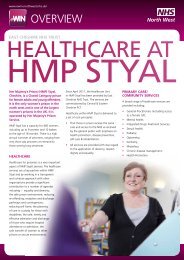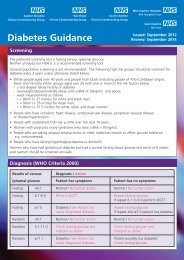Paediatric sedation guidelines 17011.pdf - East Cheshire NHS Trust
Paediatric sedation guidelines 17011.pdf - East Cheshire NHS Trust
Paediatric sedation guidelines 17011.pdf - East Cheshire NHS Trust
You also want an ePaper? Increase the reach of your titles
YUMPU automatically turns print PDFs into web optimized ePapers that Google loves.
Policy Title: Guidelines for the Sedation Of Children and Young People on<br />
the paediatric ward and in A&E<br />
Executive Summary: The purpose of the paediatric <strong>sedation</strong> guideline is to support<br />
nurses and medical staff in ensuring the safety of children<br />
requiring <strong>sedation</strong>. Procedures for which children require<br />
<strong>sedation</strong> are included, with preference of medication to be<br />
prescribed. In the event of an adverse reaction, or a dosage<br />
error, instructions are provided to manage the situation.<br />
Supersedes: Guidelines for the Sedation Of Children and Young People<br />
2005, 2010 and A&E <strong>guidelines</strong> for the <strong>sedation</strong> of young<br />
Description of<br />
Amendment(s):<br />
people and use of ketamine <strong>guidelines</strong><br />
Re –written to amalgamate both the <strong>Paediatric</strong> unit and A&E<br />
<strong>guidelines</strong>.<br />
This policy will impact on: The Children’s Ward, Emergency Dept. X-ray dept<br />
Financial Implications: Non Known<br />
Policy Area: Children’s Services Document<br />
Reference:<br />
Version Number: 3 Effective Date: June 2012<br />
Issued By:<br />
Authors:<br />
Families and Well<br />
Being<br />
Amalgamated by J<br />
Shippey<br />
Review Date: June 2014<br />
Impact Assessment<br />
Date:<br />
Consultation Phase:<br />
Received for information:<br />
APPROVAL RECORD<br />
Committees / Group<br />
<strong>Paediatric</strong>ians, Children’s<br />
Nurses, Radiographer,<br />
Associate Director W&CBU,<br />
Consultant & Practice<br />
Development Nurse in A&E,<br />
Pharmacy<br />
Date<br />
November 2011-<br />
May 2012
Guidelines for the Sedation<br />
Of Children and Young People<br />
On the <strong>Paediatric</strong> Ward and in A&E<br />
2<br />
<strong>Paediatric</strong> Sedation Guidelines amalgamated by J Shippey June 2011, for review May 2014<br />
<strong>Paediatric</strong> Ward Sedation Guidelines writtenby HH, Glover, S. Darbyshire July 2010<br />
<strong>Paediatric</strong> A&E Sedation Guidelines written by Dr M Nichol August 2011
Introduction<br />
This guideline is in two parts. Part A provides guidance for the <strong>sedation</strong><br />
of children and young people on the paediatric ward and part B<br />
provides guidance for children and young people providing <strong>sedation</strong> in<br />
the Accident and Emergency department. It has been split like this<br />
because children need <strong>sedation</strong> for different reasons in the different<br />
departments. In A&E, children need <strong>sedation</strong> for pain relief for<br />
procedures such as stitching wounds and orthopaedic reductions.<br />
However, <strong>sedation</strong> is used more commonly on the paediatric ward for<br />
procedures which could cause anxiety such as MRI scanning and<br />
invasive non painful procedures such as MCUGs.<br />
INDEX:<br />
PART A: Page 4<br />
Guidelines for nurses and doctors in the management of children<br />
requiring <strong>sedation</strong> on the paediatric ward.<br />
PART B: Page 10<br />
3<br />
<strong>Paediatric</strong> Sedation Guidelines amalgamated by J Shippey June 2011, for review May 2014<br />
<strong>Paediatric</strong> Ward Sedation Guidelines writtenby HH, Glover, S. Darbyshire July 2010<br />
<strong>Paediatric</strong> A&E Sedation Guidelines written by Dr M Nichol August 2011
PART A<br />
GUIDELINES FOR NURSES AND DOCTORS IN THE MANAGEMENT<br />
OF CHILDREN REQUIRING SEDATION ON THE PAEDIATRIC<br />
WARD<br />
INDEX<br />
PAGE<br />
1 Introduction 2<br />
2 Procedures requiring <strong>sedation</strong> 2-3<br />
3 Preferred medicines for <strong>sedation</strong> 3-4<br />
4 Guidelines for <strong>sedation</strong>: Flow chart 5<br />
5 Sedative Drugs 6-7<br />
6 Training and competence of staff 8<br />
7 Safety of patients and management of risk 8-9<br />
8 Appendix 1 - Sedation checklist 10<br />
9 Appendix 2 - <strong>Paediatric</strong> <strong>sedation</strong> assessment tool 11<br />
10 Appendix 3 - <strong>Paediatric</strong> <strong>sedation</strong> audit tool 12<br />
11 Appendix 4 - General comments 13<br />
12 Appendix 5 – Adapted Neurological observation chart 14<br />
13 Appendix 6 – Patients at risk from the effects of <strong>sedation</strong> 15<br />
14 Appendix 7 – Discharge information leaflet 16<br />
15 References 17<br />
1<br />
<strong>Paediatric</strong> Sedation Guidelines amalgamated by J Shippey June 2011, for review May 2014<br />
<strong>Paediatric</strong> Ward Sedation Guidelines writtenby HH, Glover, S. Darbyshire July 2010<br />
<strong>Paediatric</strong> A&E Sedation Guidelines written by Dr M Nichol August 2011
Section 1:<br />
INTRODUCTION<br />
<br />
<br />
<br />
The purpose of the paediatric <strong>sedation</strong> guideline is to support nurses and medical<br />
staff in ensuring the safety of children requiring <strong>sedation</strong>.<br />
The Consultant <strong>Paediatric</strong>ian/speciality <strong>Paediatric</strong>ian makes the decision that a<br />
child needs <strong>sedation</strong> for a procedure. It may be necessary for an acutely ill child<br />
already admitted to the ward to have <strong>sedation</strong> for investigations.<br />
Procedures for which children require <strong>sedation</strong> are included, with preference of<br />
medication to be prescribed. In the event of an adverse reaction, or a dosage<br />
error, instructions are provided to manage the situation.<br />
<br />
Children are not required to be starved for a period of time prior to <strong>sedation</strong> but it<br />
is advised that they only have light diet 2 hours before and clear fluids 1 hour<br />
before <strong>sedation</strong>. If sedating infants they can have milk 2 hours prior to <strong>sedation</strong>.<br />
Section 2:<br />
PROCEDURES REQUIRING SEDATION<br />
The following procedures may require <strong>sedation</strong> depending upon the age and<br />
compliance of the child:<br />
<br />
Invasive non-painful procedures<br />
Such as:<br />
Micturating Cystogram (MCG) and enema administration will normally only require<br />
Minimal Sedation. The child will then attend the children’s ward as a day case<br />
patient.<br />
Please refer to the <strong>guidelines</strong> for <strong>sedation</strong> flow chart for guidance on drug choice<br />
(page 6)<br />
<br />
Potentially painful procedures<br />
Such as:<br />
Insertion of intravenous long line, insertion and/or removal of sutures and minor<br />
surgical procedures and dressings will normally require Moderate Sedation with<br />
analgesia.<br />
Please refer to the <strong>guidelines</strong> for <strong>sedation</strong> flow chart for guidance on drug choice. For<br />
procedural <strong>sedation</strong> in A&E, staff should liaise with the A&E Consultant and if<br />
applicable the relevant ketamine procedural <strong>sedation</strong> <strong>guidelines</strong>.<br />
2<br />
<strong>Paediatric</strong> Sedation Guidelines amalgamated by J Shippey June 2011, for review May 2014<br />
<strong>Paediatric</strong> Ward Sedation Guidelines writtenby HH, Glover, S. Darbyshire July 2010<br />
<strong>Paediatric</strong> A&E Sedation Guidelines written by Dr M Nichol August 2011
Non-invasive and non-Painful procedures<br />
Such as:<br />
Magnetic resonance imaging (MRI) scan, CT scan or Electroencephalagram will<br />
require Moderate Sedation in order to achieve ultimate compliance from the child;<br />
rendering him/her completely still for the purpose of the procedure. However, the<br />
child would not require analgesia for these investigations.<br />
Please refer to the <strong>guidelines</strong> for <strong>sedation</strong> flow chart for guidance on drug choice<br />
(page 6).<br />
Section 3:<br />
PREFERRED METHODS FOR SEDATION<br />
PLEASE NOTE: <strong>East</strong> <strong>Cheshire</strong> <strong>NHS</strong> <strong>Trust</strong>s' Policy and Procedures for the safe and<br />
secure Handling of Medicines must be adhered to at all times<br />
<br />
Oral Chloral Hydrate – see flow chart for doses.<br />
It is an effective sedative and hypnotic agent that has been successfully used for<br />
patients pre-operatively to allay anxiety, prior to minor surgical procedures and<br />
diagnostic procedures (Bhatt-Mehta & Rosen, 1998). It has also been used prior to<br />
EEG evaluations to produce sleep (American Society of Health System Pharmacists<br />
Inc, 2002). This preparation is prepared as a special and therefore an unlicensed<br />
medicine.<br />
Buccal / oral, Intravenous (IV) or Intranasal Midazolam – see flow chart for<br />
doses (page 6)<br />
It provides <strong>sedation</strong> without loss of consciousness, and relieves anxiety. When<br />
administered prior to minor surgical procedures, diagnostic, therapeutic or<br />
endoscopic procedures, anterograde amnesia is also induced (Lloyd, 2000) and<br />
(American Society of Health System Pharmacists Inc, 2002). It is important to be<br />
aware that there is occasional distressing paradoxical excitation when midazolam is<br />
used with children (CSM 2001)<br />
Oral Morphine – see flow chart for doses (page 6)<br />
In the instance where a single dose of midazolam is ineffective, due to continued<br />
agitation and lack of co-operation, morphine may be administered orally or<br />
intravenously (Only by an experienced member of staff followed by close monitoring)<br />
(Henderson, 1988).<br />
3<br />
<strong>Paediatric</strong> Sedation Guidelines amalgamated by J Shippey June 2011, for review May 2014<br />
<strong>Paediatric</strong> Ward Sedation Guidelines writtenby HH, Glover, S. Darbyshire July 2010<br />
<strong>Paediatric</strong> A&E Sedation Guidelines written by Dr M Nichol August 2011
Informed consent for the procedure is obtained from the parents on the trust<br />
consent form 'Parental agreement to investigation or treatment for a child or young<br />
person.' The <strong>East</strong> <strong>Cheshire</strong> <strong>NHS</strong> <strong>Trust</strong> Policy for Consent to Examination or<br />
Treatment is followed.<br />
It is the responsibility of the Consultant / Doctor performing the procedure to:<br />
1. Provide the parents with information and the top copy of the consent form<br />
(completed by the consultant) prior to the procedure.<br />
2. Check the level of understanding and knowledge the parents have regarding the<br />
procedure, upon admission to the paediatric unit. Queries to be answered by<br />
doctor undertaking procedure (or healthcare professional assessed as competent<br />
to give this information).<br />
3. Obtain parental signature on Page 3 of the consent form.<br />
It is the responsibility of the nurse in charge of the patient's care to:<br />
1. Obtain accurate patient history prior to <strong>sedation</strong>, using the <strong>sedation</strong> checklist<br />
(appendix 1)<br />
2. Use care and good judgement to obtain this information. Use existing case<br />
notes to confirm information available.<br />
3. Ensure that the Doctor completes the <strong>Paediatric</strong> <strong>sedation</strong> assessment and<br />
audit tool prior to <strong>sedation</strong> (appendix 2).<br />
4. The named nurse to attend pre, per, and post the procedure in order to<br />
monitor patient wellbeing throughout.<br />
4<br />
<strong>Paediatric</strong> Sedation Guidelines amalgamated by J Shippey June 2011, for review May 2014<br />
<strong>Paediatric</strong> Ward Sedation Guidelines writtenby HH, Glover, S. Darbyshire July 2010<br />
<strong>Paediatric</strong> A&E Sedation Guidelines written by Dr M Nichol August 2011
Section 4<br />
GUIDELINES FOR SEDATION: Flow Chart<br />
Contraindications to <strong>sedation</strong>:<br />
Support Facilities which must be available:<br />
Abnormality of upper airway Resus equipment & paed. Defibrillator<br />
Abnormality of respiratory centre Suction equipment<br />
Renal or hepatic dysfunction Oxygen, airway & mask<br />
Gestational age
Section 4b<br />
Sedative Drugs<br />
Please note MAXIMUM drug dosages<br />
See Children’s British National Formulary (current edition) for further<br />
prescribing information<br />
Route Drug Dose Max. Dose When to give Antidote<br />
Oral Morphine 2years<br />
500mcg/kg<br />
15mg<br />
90mins before<br />
procedure<br />
Oral Midazolam 500mcg/kg 15mg 30 - 60mins before<br />
procedure<br />
6<br />
<strong>Paediatric</strong> Sedation Guidelines amalgamated by J Shippey June 2011, for review May 2014<br />
<strong>Paediatric</strong> Ward Sedation Guidelines writtenby HH, Glover, S. Darbyshire July 2010<br />
<strong>Paediatric</strong> A&E Sedation Guidelines written by Dr M Nichol August 2011<br />
Naloxone<br />
1 month<br />
- 12<br />
years<br />
10mcg/kg<br />
with<br />
subsequent<br />
doses of<br />
100mcg/kg<br />
if no<br />
response.<br />
12-18<br />
years<br />
0.4-2mg<br />
repeated at<br />
2-3 min<br />
intervals to<br />
a max. of<br />
10mg<br />
Flumazenil<br />
1 month -<br />
12 years<br />
10mcg/kg<br />
(max single<br />
dose<br />
200mcg)<br />
repeated at<br />
1-minute<br />
intervals to<br />
a max. total<br />
dose of<br />
40mcg/kg or<br />
1g<br />
12 - 18<br />
years<br />
200mcg<br />
repeated at<br />
1-minute<br />
intervals if<br />
required to
Route Drug Dose Max<br />
dose<br />
Oral Chloral 25-50mg/kg 1g or<br />
Hydrate<br />
100mg / kg<br />
(2g max) if<br />
respiratory<br />
monitoring<br />
in place<br />
When to give<br />
45-60mins before<br />
procedure<br />
Nasal Midazolam 200-300mcg/kg 300mcg/kg 5-10 mins before<br />
procedure<br />
IV Midazolam 1month - 6 years 300mcg/kg Immediately before<br />
50-100mcg/kg or 6mg procedure<br />
6 -12 years<br />
25 -50mcg/kg 10mg<br />
12-18 years<br />
2-2.5mg; increase in 3.5-7.5mg<br />
steps of 0.5-1mg if<br />
necessary<br />
IV<br />
(injectio<br />
n over 5<br />
min.)<br />
Morphine 1-6 month<br />
100 - 200mcg/kg - 6<br />
hourly.<br />
6 months - 12<br />
years<br />
100 - 200mcg/kg - 4<br />
hourly.<br />
12 - 18 year<br />
2.5 - 10mg - 4<br />
hourly<br />
Immediately before<br />
procedure<br />
a max. total<br />
dose of 1g<br />
Antidote<br />
None<br />
Flumazenil<br />
Flumazenil<br />
Naloxone<br />
NOTE<br />
IV (Intravenous) <strong>sedation</strong> only to be given by a Doctor or an appropriately trained nurse<br />
Mcg = Micrograms<br />
Children do not require a period of starving prior to <strong>sedation</strong>. However, it is<br />
recommended for any of the drugs above that the child has:<br />
Light diet up to 2 hours<br />
Clear fluid up to 1 hour prior to <strong>sedation</strong>.<br />
Infants may have milk 2 hours prior to <strong>sedation</strong>.<br />
7<br />
<strong>Paediatric</strong> Sedation Guidelines amalgamated by J Shippey June 2011, for review May 2014<br />
<strong>Paediatric</strong> Ward Sedation Guidelines writtenby HH, Glover, S. Darbyshire July 2010<br />
<strong>Paediatric</strong> A&E Sedation Guidelines written by Dr M Nichol August 2011
Section 5:<br />
TRAINING AND COMPETENCE<br />
<br />
Nurses caring for patients requiring <strong>sedation</strong> on the <strong>Paediatric</strong> Unit will be<br />
qualified children’s nurses, registered with the NMC.<br />
<br />
Doctors conducting <strong>sedation</strong> must be of middle grade experience or above<br />
<br />
Mandatory training in basic life support and anaphylaxis are essential<br />
requirements and must be updated yearly.<br />
<br />
Adherence to the <strong>East</strong> <strong>Cheshire</strong> <strong>NHS</strong> <strong>Trust</strong> Policy for the safe and secure<br />
handling of medicines, and the Policy for consent to examination or<br />
treatment is imperative.<br />
<br />
Relevant issues encompass:<br />
- Understanding and safe use of equipment (see flow chart)<br />
- Understanding the possible complications and hazards of the<br />
procedure of <strong>sedation</strong> (see appendix 3 and 4)<br />
- Completion of all the relevant documentation in accordance with<br />
EC<strong>NHS</strong> trusts' policy<br />
Section 6:<br />
Safety of Patients and Management of Risks<br />
<br />
Adherence to the <strong>East</strong> <strong>Cheshire</strong> <strong>NHS</strong> <strong>Trust</strong> Policy for the safe and secure<br />
handling of medicines, and the Policy for consent to examination or<br />
treatment is imperative.<br />
<br />
Immediate action is to seek medical advice.<br />
<br />
Ensure patient safety, maintaining airway.<br />
<br />
In the event of respiratory arrest, call 2222 and administer basic life support.<br />
8<br />
<strong>Paediatric</strong> Sedation Guidelines amalgamated by J Shippey June 2011, for review May 2014<br />
<strong>Paediatric</strong> Ward Sedation Guidelines writtenby HH, Glover, S. Darbyshire July 2010<br />
<strong>Paediatric</strong> A&E Sedation Guidelines written by Dr M Nichol August 2011
Medicines other than those referred to in these <strong>guidelines</strong> may be proposed for<br />
use. Sometimes this is necessary in order to achieve the desired result. The<br />
Consultant in charge of the child's care, following discussion with a pharmacist<br />
takes this decision. The medicines dosage and route of administration must<br />
remain within the <strong>guidelines</strong> of the British National Formulary for Children<br />
The information within these <strong>guidelines</strong> has been gleaned from <strong>sedation</strong> <strong>guidelines</strong><br />
implemented in other <strong>NHS</strong> trusts. It is therefore courteous to acknowledge Alder<br />
Hey children’s Hospital and North Staffordshire Hospital trusts in their contribution.<br />
Audit<br />
These <strong>guidelines</strong> will be audited in line with the KPI’s identified below on an annual<br />
basis by paediatric nursing staff. The findings will be reported to the <strong>Paediatric</strong> Unit<br />
and the <strong>Paediatric</strong> Audit Group and Clinical Governance. Any action plans<br />
developed from this audit will be agreed by the <strong>Paediatric</strong> Audit group with a 6<br />
monthly review of progress.<br />
Key Performance Indicators<br />
An annual audit of patients requiring <strong>sedation</strong> will be carried out for<br />
complications e.g. failed procedure, adverse reaction, to ascertain that<br />
procedures were carried out as per the <strong>guidelines</strong>.<br />
Appropriate prescription of medication depending on the procedure that the<br />
child is admitted for, in line with <strong>East</strong> <strong>Cheshire</strong> <strong>NHS</strong> <strong>Trust</strong> Medicines<br />
Management Policy and Record Keeping policy.<br />
The child’s records hold completed documents of appendix1, 2, 3 and 5.<br />
9<br />
<strong>Paediatric</strong> Sedation Guidelines amalgamated by J Shippey June 2011, for review May 2014<br />
<strong>Paediatric</strong> Ward Sedation Guidelines writtenby HH, Glover, S. Darbyshire July 2010<br />
<strong>Paediatric</strong> A&E Sedation Guidelines written by Dr M Nichol August 2011
Appendix 1<br />
SEDATION CHECKLIST PRIOR TO TRANSFER TO DEPARTMENT<br />
To be completed by named nurse<br />
1. Correct identification band: yes / no<br />
2. Allergies yes / no<br />
3. Sedation assessment form completed: yes / no<br />
4. Cannula in situ: yes / no<br />
5. Consent form signed: yes / no<br />
6. Notes / x-rays / scans yes / no<br />
7. Prescription chart complete with <strong>sedation</strong> and antidote: yes / no<br />
8. Glasses / nail varnish / jewellery removed: yes / no<br />
9. Loose teeth / caps / brace yes / no<br />
10. Fasted from:<br />
Date:_________<br />
Time:_________<br />
11. Any variance from above, please record below<br />
Transfer nurse to complete checklist. Print name<br />
Signed:<br />
10<br />
<strong>Paediatric</strong> Sedation Guidelines amalgamated by J Shippey June 2011, for review May 2014<br />
<strong>Paediatric</strong> Ward Sedation Guidelines writtenby HH, Glover, S. Darbyshire July 2010<br />
<strong>Paediatric</strong> A&E Sedation Guidelines written by Dr M Nichol August 2011
Appendix 2<br />
PAEDIATRIC SEDATION ASSESSMENT TOOL<br />
Part 1 to be completed by medical staff before prescribing <strong>sedation</strong><br />
ADDRESS<br />
DATE:<br />
NAME:<br />
D.O.B:<br />
WEIGHT:<br />
PROCEDURE:<br />
Part 1<br />
Do any of the following relative or absolute contra-indications to <strong>sedation</strong> apply to the patient?<br />
(see appendix 4)<br />
Raised intracranial pressure yes / no<br />
Altered conscious level yes / no<br />
Compromised airway yes / no<br />
Upper / lower respiratory tract infection yes / no<br />
Respiratory failure yes / no<br />
History of apnoea yes / no<br />
Uncontrolled epilepsy yes / no<br />
Gastro-oesophageal reflux yes / no<br />
Significant renal, hepatic or cardiac dysfunction yes / no<br />
11<br />
<strong>Paediatric</strong> Sedation Guidelines amalgamated by J Shippey June 2011, for review May 2014<br />
<strong>Paediatric</strong> Ward Sedation Guidelines writtenby HH, Glover, S. Darbyshire July 2010<br />
<strong>Paediatric</strong> A&E Sedation Guidelines written by Dr M Nichol August 2011
If any of the above exists, check with consultant or middle grade that <strong>sedation</strong> is<br />
appropriate.<br />
Checked<br />
Yes / No<br />
Are you satisfied that the parent /Guardian understands the nature of the procedure, and that<br />
there is a failure rate with <strong>sedation</strong>?<br />
Yes / No<br />
Name: ………………………………………………….. Signed: ……………………………………..<br />
PAEDIATRIC SEDATION AUDIT TOOL<br />
Appendix 3<br />
To be completed by the child’s named nurse following the procedure:<br />
Was the <strong>sedation</strong> procedure carried out successfully? YES NO<br />
If no, please complete sections below:<br />
Reason <strong>sedation</strong> procedure unsuccessful: (tick below as appropriate)<br />
Patient agitated<br />
Adverse effect<br />
Parents withdrew consent<br />
Other (provide details): ……………………………………….………………………………<br />
……………………………………………………………………………………………………<br />
……………………………………………………………………………………………………<br />
Problems with equipment YES NO<br />
(if yes, tick below as appropriate)<br />
Suitability of probe<br />
Accuracy of probe readings<br />
O 2 sats monitor<br />
12<br />
<strong>Paediatric</strong> Sedation Guidelines amalgamated by J Shippey June 2011, for review May 2014<br />
<strong>Paediatric</strong> Ward Sedation Guidelines writtenby HH, Glover, S. Darbyshire July 2010<br />
<strong>Paediatric</strong> A&E Sedation Guidelines written by Dr M Nichol August 2011
Other (provide details): ……………………………………………………………………….<br />
……………………………………………………………………………………………………<br />
……………………………………………………………………………………………………<br />
Documentation completed prior to transfer<br />
YES<br />
NO<br />
Sedation checklist completed by named nurse<br />
Assessment tool completed by medical staff<br />
Discharge letter completed:<br />
Appendix 4<br />
General comments regarding the <strong>sedation</strong> of children<br />
<br />
Sedation and anaesthesia are a spectrum.<br />
If you give enough ‘<strong>sedation</strong>’ to a patient it can induce anaesthesia, i.e. loss of<br />
consciousness, loss of protective airway reflexes and the inability to feel<br />
pain. Giving drugs such as Midazolam and morphine IV, and in conjunction with<br />
one and other, carries a significant risk of respiratory depression. The drugs must<br />
not be given too rapidly. If the procedure for which <strong>sedation</strong> is indicated is likely to<br />
be painful, then titrate analgesia first then deliver the sedative.<br />
The fine distinction lies in the ability of the patient to maintain vital functions without<br />
assistance, and their response to being roused, i.e.:<br />
<br />
<br />
<br />
protection of airway, swallowing, cough reflex<br />
respiration<br />
cardiovascular stability<br />
Loss of any of the above reflexes is routine in anaesthetic environments but should<br />
not occur when providing <strong>sedation</strong>.<br />
VITAL FUNCTION SEDATION ANAESTHESIA<br />
Response to verbal Present<br />
Absent<br />
stimulus<br />
Respiration Rate and depth may be Rate and depth markedly<br />
slightly reduced<br />
reduced or absent<br />
Swallowing reflex Present Absent (usually)<br />
Gag reflex Present Absent<br />
13<br />
<strong>Paediatric</strong> Sedation Guidelines amalgamated by J Shippey June 2011, for review May 2014<br />
<strong>Paediatric</strong> Ward Sedation Guidelines writtenby HH, Glover, S. Darbyshire July 2010<br />
<strong>Paediatric</strong> A&E Sedation Guidelines written by Dr M Nichol August 2011
Cough reflex Laryngeal spasm unlikely,<br />
but possible with sufficient<br />
provocation<br />
Cardiovascular stability Mild hypotension may<br />
occur<br />
May be present at lighter<br />
levels but unlikely.<br />
Laryngeal spasm may<br />
occur<br />
Severe hypotension may<br />
occur<br />
(Adapted from: North Staffordshire Hospitals <strong>Trust</strong>, Guidelines for <strong>sedation</strong> of children.)<br />
14<br />
<strong>Paediatric</strong> Sedation Guidelines amalgamated by J Shippey June 2011, for review May 2014<br />
<strong>Paediatric</strong> Ward Sedation Guidelines writtenby HH, Glover, S. Darbyshire July 2010<br />
<strong>Paediatric</strong> A&E Sedation Guidelines written by Dr M Nichol August 2011
15<br />
<strong>Paediatric</strong> Sedation Guidelines amalgamated by J Shippey June 2011, for review May 2014<br />
<strong>Paediatric</strong> Ward Sedation Guidelines writtenby HH, Glover, S. Darbyshire July 2010<br />
<strong>Paediatric</strong> A&E Sedation Guidelines written by Dr M Nichol August 2011
Appendix 6<br />
PATIENTS AT RISK FROM THE EFFECTS OF SEDATION<br />
<br />
<br />
Some children are more vulnerable to the effects of <strong>sedation</strong><br />
Broad summary – those with problems of respiration or upper airway problems<br />
Upper Airway Obstruction<br />
<br />
<br />
<br />
<br />
<br />
Croup<br />
Foreign body<br />
Congenital stridor?<br />
cause Pierre-Robin /<br />
Cleft palate<br />
Baby with very blocked<br />
nose<br />
Pre-existing<br />
neuromuscular<br />
problems<br />
Respiration<br />
<br />
Loss of reflexes<br />
Effects of <strong>sedation</strong>:<br />
Central drive (or<br />
children at risk if CO 2<br />
)<br />
Swallowing difficulties.<br />
Known bulbar problems,<br />
especially if combined<br />
with gastric reflux.<br />
Gastro-oesophageal reflux<br />
Those at risk:<br />
HEAD INJURIES<br />
ICP – space occupying<br />
lesions. Already receiving<br />
opiates<br />
Congenital hypoventilation<br />
syndrome<br />
<br />
Muscle power (or<br />
respiratory efficiency)<br />
<br />
<br />
<br />
Myopathies<br />
Post ICU – generalised<br />
weakness.<br />
All small babies<br />
(especially premature<br />
babies)<br />
Lung performance Chest infection. Large<br />
effusions<br />
Severe<br />
Bronchpulmonary<br />
dysplasia. Any child<br />
requiring oxygen<br />
Cardiovascular Hypotension Haemorrhage<br />
Sepsis<br />
Cardiomyopathy/<br />
16<br />
<strong>Paediatric</strong> Sedation Guidelines amalgamated by J Shippey June 2011, for review May 2014<br />
<strong>Paediatric</strong> Ward Sedation Guidelines writtenby HH, Glover, S. Darbyshire July 2010<br />
<strong>Paediatric</strong> A&E Sedation Guidelines written by Dr M Nichol August 2011
cardiac injury<br />
Appendix 7<br />
Children's Ward<br />
Macclesfield District General Hospital<br />
<strong>East</strong> <strong>Cheshire</strong> <strong>NHS</strong> <strong>Trust</strong><br />
Victoria Road<br />
Macclesfield<br />
<strong>Cheshire</strong><br />
SK10 3BL<br />
Dear Parent<br />
Your child attended the Children’s Unit as a day case patient<br />
on ___________________ for ____________________________________<br />
s/he was sedated with _______________________________ at __________am/pm.<br />
You may find that your child is a little unsteady when you get home, but this<br />
should gradually improve. Allow your child to sleep if they wish and to eat and<br />
drink as normal.<br />
If you have any worries or concerns, please contact the Children’s Ward on<br />
telephone number 01625 661080 of 661084 and ask to speak to the nurse in<br />
charge who will be pleased to help and advise you.<br />
Kind regards,<br />
17<br />
<strong>Paediatric</strong> Sedation Guidelines amalgamated by J Shippey June 2011, for review May 2014<br />
<strong>Paediatric</strong> Ward Sedation Guidelines writtenby HH, Glover, S. Darbyshire July 2010<br />
<strong>Paediatric</strong> A&E Sedation Guidelines written by Dr M Nichol August 2011
PART B<br />
Sedation in Children and Young<br />
People in A&E (Reference Guide)<br />
If intending to use Ketamine then use the separate Ketamine<br />
guidance.<br />
What is this guide for?<br />
This guide is to help staff in the emergency department perform safe <strong>sedation</strong> of<br />
children and young people for short procedures.<br />
It can be used to achieve minimal, moderate, conscious and deep <strong>sedation</strong> (defined<br />
by the ASA) for procedures that the child would not normally be able to tolerate.<br />
Examples of what the guide could be used for are:<br />
Painless imaging (do not routinely use ketamine or opioids).<br />
<br />
Painful procedures e.g. orthopaedic manipulation or reduction.<br />
It is intended for sedative techniques using:<br />
Nitrous oxide with or without Midazolam.<br />
Midazolam with or without fentanyl (or other opioid).<br />
It can also be used for specialist <strong>sedation</strong> techniques such as propofol +/-<br />
fentanyl if appropriately trained (propofol must NOT be used without specific<br />
anaesthetic experience).<br />
Who should be using this guidance?<br />
Healthcare professionals delivering <strong>sedation</strong> should have:<br />
Knowledge and understanding of and competency in:<br />
o Sedation drug pharmacology and applied physiology.<br />
o Assessment of young people.<br />
o Complications and their immediate management, including paediatric<br />
life support.<br />
<br />
Practical experience of:<br />
o Effectively delivering the chosen technique and managing<br />
complications.<br />
<br />
Documented up-to-date evidence of competency.<br />
18<br />
<strong>Paediatric</strong> Sedation Guidelines amalgamated by J Shippey June 2011, for review May 2014<br />
<strong>Paediatric</strong> Ward Sedation Guidelines writtenby HH, Glover, S. Darbyshire July 2010<br />
<strong>Paediatric</strong> A&E Sedation Guidelines written by Dr M Nichol August 2011
Does the child need to be fasted?<br />
Fasting is not needed for minimal <strong>sedation</strong>, <strong>sedation</strong> with nitrous oxide, moderate<br />
<strong>sedation</strong> during which the child will maintain verbal contact with the healthcare<br />
professional. Apply the 2-4-6 rule for other elective procedures. Elective situation is<br />
uncommon in Emergency Dept but may arise if a procedure as being identified on<br />
one day but deferred to be done the next day. It should be recognised that<br />
starvation does NOT guarantee lack of vomiting, based on published research.<br />
For an emergency procedure base the decision to proceed on the urgency of the<br />
procedure and the target depth of <strong>sedation</strong>.<br />
Is <strong>sedation</strong> suitable for the child or young person?<br />
<br />
<br />
<br />
Trained healthcare professionals should carry out pre-<strong>sedation</strong> assessments and documents the<br />
results in the healthcare record.<br />
Two trained healthcare professionals should be available during <strong>sedation</strong>.<br />
Immediate access to resuscitation and monitoring equipment should be available during <strong>sedation</strong>.<br />
Establish suitability for <strong>sedation</strong> by assessing:<br />
current medical condition and any surgical problems<br />
weight<br />
past medical problems (including any associated with previous <strong>sedation</strong> or anaesthesia)<br />
current and previous medication (including allergies)<br />
physical status (including the airway)<br />
psychological and development status<br />
Do any of the following apply?<br />
There is concern about a potential airway or breathing<br />
problem.<br />
The child or young person is ASA grade 3 or greater.<br />
The patient is a neonate or infant.<br />
Yes<br />
Seek specialist advice<br />
(before delivering<br />
<strong>sedation</strong>).<br />
No<br />
Choose the most suitable <strong>sedation</strong> technique based on all the follow factors:<br />
what the procedure involves<br />
target level of <strong>sedation</strong><br />
contraindications<br />
side effects<br />
patient (or parent or carer) preference<br />
staff training<br />
Offer the child or young person and their parents or carers verbal and written information on all of the following:<br />
proposed <strong>sedation</strong> technique<br />
Alternatives to <strong>sedation</strong>. This should also detail that GA may be an alternative, and may depending on age,<br />
be referred to Manchester Children’s Hospital for that to happen due to age restriction on GA in children in<br />
DGH.<br />
associated risks and benefits<br />
Obtain and document informed consent<br />
19<br />
<strong>Paediatric</strong> Sedation Guidelines amalgamated by J Shippey June 2011, for review May 2014<br />
<strong>Paediatric</strong> Ward Sedation Guidelines writtenby HH, Glover, S. Darbyshire July 2010<br />
<strong>Paediatric</strong> A&E Sedation Guidelines written by Dr M Nichol August 2011
If you are unclear about any of the above terms please consult the full NICE<br />
guidance.<br />
Check list for <strong>sedation</strong> of a child or young person<br />
Name:<br />
DOB:<br />
Hospital Number:<br />
Indication for <strong>sedation</strong>:<br />
Intended procedure:<br />
Intended level of <strong>sedation</strong>:<br />
Intended method of <strong>sedation</strong>:<br />
Time last ate and what:<br />
Age:<br />
Weight:<br />
Preoperative assessment:<br />
Past medical problems Yes □ No □<br />
Past anaesthetic problems Yes □ No □<br />
Current medication Yes □ No □<br />
Allergies<br />
Airway concerns Yes □ No □<br />
SpO 2 , RR, HR and pain score recorded Yes □ No □<br />
Written consent obtained Yes □ No □<br />
Written information given Yes □ No □<br />
Equipment:<br />
Supplementary oxygen Yes □ No □<br />
X-ray trolley Yes □ No □<br />
Trolley capable of head down tilt Yes □ No □<br />
Resuscitation equipment available Yes □ No □<br />
Monitoring<br />
B: Respiration Yes □ No □<br />
B: Oxygen saturation Yes □ No □<br />
B: End tidal CO 2 * Yes □ No □<br />
C: Heart rate Yes □ No □<br />
C: BP (every 5 mins)* Yes □ No □<br />
C: Three-lead ECG* Yes □ No □<br />
D: Pain Yes □ No □<br />
D: Depth of <strong>sedation</strong> A V P U<br />
(circle appropriate)<br />
20<br />
<strong>Paediatric</strong> Sedation Guidelines amalgamated by J Shippey June 2011, for review May 2014<br />
<strong>Paediatric</strong> Ward Sedation Guidelines writtenby HH, Glover, S. Darbyshire July 2010<br />
<strong>Paediatric</strong> A&E Sedation Guidelines written by Dr M Nichol August 2011
*Only needed for deep <strong>sedation</strong>.<br />
Drugs:<br />
Drug: Dose: Time:<br />
Drug: Dose: Time:<br />
Nitrous oxide Yes □ No □<br />
Antagonists available Yes □ No □<br />
Level of <strong>sedation</strong>:<br />
Responds to verbal stimulus Yes □ No □<br />
Responds to painful stimulus Yes □ No □<br />
Airway patent Yes □ No □<br />
Post-<strong>sedation</strong>:<br />
Airway patent Yes □ No □<br />
Protecting airway Yes □ No □<br />
Haemodynamically stable Yes □ No □<br />
Easily roused Yes □ No □<br />
Morbidity /Complications recorded Yes □ No □<br />
Discharge criteria:<br />
Vital signs have returned to normal levels Yes □ No □<br />
Patient is awake Yes □ No □<br />
No further risk of reduced level of consciousness Yes □ No □<br />
Vomiting Yes □ No □<br />
References:<br />
NICE Clinical Guideline 112: Sedation in Children and Young People published in<br />
December 2010.<br />
Appendix (added Aug 2011)<br />
21<br />
<strong>Paediatric</strong> Sedation Guidelines amalgamated by J Shippey June 2011, for review May 2014<br />
<strong>Paediatric</strong> Ward Sedation Guidelines writtenby HH, Glover, S. Darbyshire July 2010<br />
<strong>Paediatric</strong> A&E Sedation Guidelines written by Dr M Nichol August 2011
Ketamine Guidance<br />
The guidance on ketamine below will replicate much of what is written above, but<br />
this appendix is used by ED staff as quick reference guide, without need to work<br />
through the rest of the document<br />
Ketamine pack containing<br />
<br />
<br />
<br />
<br />
<br />
Guidelines for use of ketamine<br />
What to use it for<br />
Contraindications<br />
Side effects<br />
General Preparation<br />
Equipment needed<br />
Sedation Procedure<br />
Recovery<br />
Check list form-ketamine <strong>sedation</strong><br />
Ketamine information sheet for parents<br />
Ketamine dosage table<br />
Atropine dosage table<br />
Ketamine check list<br />
Check list form<br />
Ketamine information sheet for parents<br />
From file “guidance for ketamine in Macc ED 2011” on electronic folder ED teaching<br />
on main AE nurse login<br />
What to use it for<br />
Any child who requires a painful procedure not exceeding 20minute duration<br />
performed in the A&E department but would not be able to tolerate (combative<br />
children) the procedure without <strong>sedation</strong>.<br />
This may include<br />
1. Lacerations<br />
2. Finger tip injuries<br />
3. Removal of Foreign Bodies<br />
4. Reduction of dislocations<br />
5. occasionally burns dressing changes<br />
Initially the procedure must be undertaken by a consultant or middle grade A&E<br />
doctor (specifically trained in ketamine <strong>sedation</strong>) with a qualified A&E nurse.<br />
22<br />
<strong>Paediatric</strong> Sedation Guidelines amalgamated by J Shippey June 2011, for review May 2014<br />
<strong>Paediatric</strong> Ward Sedation Guidelines writtenby HH, Glover, S. Darbyshire July 2010<br />
<strong>Paediatric</strong> A&E Sedation Guidelines written by Dr M Nichol August 2011
Contraindications for use of ketamine<br />
Common contra-indications<br />
0. Inadequate nursing staff to provide 1:1 cares till <strong>sedation</strong> worn off<br />
1. Current respiratory tract infection<br />
2. significant head injury or altered loss of consciousness<br />
3. Aged less than 1 year old<br />
Uncommon contra-indications<br />
1. Co-existing injury for which GA is necessary<br />
2. Severe cognitive or motor delay.<br />
3. Hypertension, congenital heart disease, severe behavioural problems, previous<br />
psychosis, or porphyria.<br />
4. Uncontrolled epilepsy<br />
5. Intracranial hypertension with CSF obstruction<br />
6. hyperthyroidism, or thyroxine medication<br />
7. Glaucoma or penetrating ocular injury<br />
8. Prior adverse reaction to ketamine.<br />
Caution<br />
Recent food intake is not a contraindication to procedural <strong>sedation</strong> (Annals Emer<br />
Med 1998, 31,663-677) and no specific time period of starvation guarantees an<br />
empty stomach, or avoidance of vomiting.<br />
As children get older (age> 8yo) they, and adults, are more likely to have<br />
emergence delirium-therefore consider alternative <strong>sedation</strong><br />
Side effects<br />
1. Ketamine can very rarely cause laryngospasm, resulting in noisy<br />
breathing. This is usually dealt with by using a simple airway opening-head<br />
tilt/chin lift/jaw thrust- manoeuvres with oxygen.<br />
2. Vomiting 10%<br />
3. Transient red rash in 10%<br />
4. Lacrimation and salivation 10%<br />
5. Rarely, vivid dreams in children.<br />
6. Brief tonic clonic movements. These are not epileptic seizures<br />
7. Emergence delirium with hallucinations may occur but is usually mild and<br />
does not require specific treatment-it settles within 1 hr and in children is not<br />
helped by Midazolam.<br />
General Preparation<br />
1. The parent must be given the advice sheet on ketamine.<br />
2. Informed consent MUST be obtained, and a consent form signed.<br />
3. The child must be accurately weighed and the weight documented.<br />
4. If a delay of over 45 minutes is likely e.g. the child is not fasted for 1hr, then<br />
apply topical local anaesthetic cream to the thigh in readiness for the I.M.<br />
ketamine injection.<br />
23<br />
<strong>Paediatric</strong> Sedation Guidelines amalgamated by J Shippey June 2011, for review May 2014<br />
<strong>Paediatric</strong> Ward Sedation Guidelines writtenby HH, Glover, S. Darbyshire July 2010<br />
<strong>Paediatric</strong> A&E Sedation Guidelines written by Dr M Nichol August 2011
5. Ensure that the paediatric resuscitation equipment is available in the<br />
resuscitation room or major trauma room and that the suction, pulse oximeter<br />
and oxygen is available and working.<br />
6. Note time the child last ate drank. For an emergency procedure in a child who<br />
has not fasted, base the decision to proceed with <strong>sedation</strong> on the urgency of the<br />
procedure. If the department is very busy it may be appropriate to defer the<br />
<strong>sedation</strong> till following morning in which case apply 2-4-6 fasting rule: 2hr for clear<br />
fluids-4hr for breast milk-6hr for solids. Please BE AWARE this does NOT<br />
guarantee and empty stomach so still check suction and head down tilt on<br />
trolley.<br />
Equipment Needed<br />
Ketamine and atropine dosage chart<br />
Atropine<br />
500mcg/ml or 600mcg/ml<br />
Ketamine vial<br />
1ml syringe without attached needle<br />
2 orange needles<br />
A vomit bowl<br />
Appropriate equipment for the procedure<br />
Sedation Procedure<br />
1. The appropriate volume of 2.5mg/kg ketamine and 10mcg /kg atropine<br />
should be drawn up together into one syringe 1or 2 ml<br />
2. The injection is given in the outer aspect of the middle thigh (at the site of the<br />
EMLA if used).Injection MUST be IM not subcut.-consider blue needle<br />
3. The time of injection should be noted, and after 5 minutes the child’s state of<br />
awareness should be assessed. The ideal state is one where by the painful<br />
area can be handled without the child becoming distressed. If the desired<br />
degree of <strong>sedation</strong> is not achieved with the first injection then a second dose<br />
of Ketamine (1.5 mg/kg) may be given.<br />
4. Local anaesthetic should be injected into any wound requiring suturing.<br />
During the procedure the nurse may have to gently hold the child’s head or limbs,<br />
as the child may move their head or her arms in a random fashion.<br />
Recovery.<br />
At the end of the procedure the child should be placed on his or her side with<br />
a vomit bowl available on the trolley. During this period the child may appear<br />
confused, say inappropriate words, sing or cry as he or she wakes up. After<br />
about 30 minutes the child can be transferred to an alternative area.<br />
The child will be allowed home once they fully recognise their parent(s) and ideally<br />
can walk unaided. (At home the child should not walk independently for the first 2<br />
hours after discharge). This will normally take 60 to 90 minutes. During this period,<br />
the parents should be advised to keep the child as still as possible, as rapid<br />
movements may precipitate an episode of vomiting.<br />
Only clear fluids should be allowed during this time, because vomiting can occur<br />
during this period.<br />
24<br />
<strong>Paediatric</strong> Sedation Guidelines amalgamated by J Shippey June 2011, for review May 2014<br />
<strong>Paediatric</strong> Ward Sedation Guidelines writtenby HH, Glover, S. Darbyshire July 2010<br />
<strong>Paediatric</strong> A&E Sedation Guidelines written by Dr M Nichol August 2011
References:<br />
College of Emergency medicine: Ketamine Sedation of Children in EDs Sept 2009,<br />
NICE Clinical Guideline 112. Sedation in Children and young People.<br />
Check list form- Ketamine <strong>sedation</strong><br />
Procedure<br />
Age<br />
Weight<br />
__________________________<br />
______yrs<br />
______kg<br />
CALCULATED DOSES OF<br />
Any contra-indications to ketamine?<br />
• Parents read the information sheet?<br />
• consent form signed<br />
yes no<br />
yes no<br />
yes no<br />
• child’s weight documented in the A&E card<br />
yes no<br />
• Ametop applied to thigh if there is a delay of over 30 minutes<br />
yes no<br />
• A least 3 staff required: Dr to manage the airway after <strong>sedation</strong>, clinician to perform the<br />
procedure, experienced nurse to support the patient, document physiological observations<br />
support the family and the staff<br />
• Child transferred to critical care room or Resus.<br />
yes no<br />
• suction and oxygen to hand and working<br />
yes no<br />
• pulse oximetry used<br />
• NICE guidance recommends capnography<br />
yes no<br />
yes /no<br />
• 3 lead ECG and Blood pressure monitoring<br />
yes no<br />
Suture set plus local anaesthetic / dressing pack as appropriate yes no<br />
•<br />
• Atropine 0.6mg vials, 1ml syringe without attached needle plus orange needles.<br />
• Ketamine 50mg/ml vial- drug dosages calculated<br />
• Second dose ketamine if necessary<br />
• adverse reactions recorded in the A&E card yes no<br />
• doctor code on Extramed CRIS-<strong>sedation</strong> (within treatment column), over and above suture or f.b<br />
removal as applicable<br />
• follow up arranged<br />
25<br />
<strong>Paediatric</strong> Sedation Guidelines amalgamated by J Shippey June 2011, for review May 2014<br />
<strong>Paediatric</strong> Ward Sedation Guidelines writtenby HH, Glover, S. Darbyshire July 2010<br />
<strong>Paediatric</strong> A&E Sedation Guidelines written by Dr M Nichol August 2011
• Ensure parents are given a vomit bowl in the cubicle and when discharged<br />
Ketamine Information Sheet for parents<br />
If you are reading this it means your child probably has a cut that needs stitches and that your child<br />
would be distressed /combative with just a needle of local anaesthetic<br />
The purpose of this information sheet is to help reduce some of the stress you will be having<br />
from bringing your child into hospital.<br />
Ketamine is<br />
is a reliable drug for making children sleepy<br />
which, after an injection in the leg, usually works by 5 minutes,<br />
It lasts for about 15 minutes and then your child will gradually wake up over an hour<br />
Ketamine is not<br />
A general anaesthetic, in the dose we use here<br />
Are there any side effects?<br />
As the drug takes effect your child will get wobbly eye movements, and may make small jerky<br />
movements of the legs or arms<br />
As the drug wears off, some children, particularly if they are over 8 years old, may hallucinate<br />
and swear-this is called emergence delirium and is usually mild (in 20%)<br />
As the drug wears off they are very wobbly –as if drunk-and unsafe on their feet for<br />
approximately an hour or so.<br />
Some children get a rash<br />
Some children vomit. This happens usually in A&E after they have woken up fully. Occasionally<br />
they may continue to vomit for up to 24 hours, but this does not require admission or treatment.<br />
What alternative exist?<br />
Depending on the problem and child’s age e.g. wound or foreign body, the only alternative may be<br />
transfer to Manchester children hospital, hospital admission, and general anaesthetic to achieve<br />
the same end point.<br />
While risks of General anaesthesia in current practice are very low, the risks exceed <strong>sedation</strong>.<br />
Vomiting can exit after both approaches: GA or <strong>sedation</strong>. Emergency delirium while uncommon and<br />
self limiting does not occur after GA.<br />
Different drugs for <strong>sedation</strong> may be considered again depending on weight of child and the Dr may<br />
go into detail, if you wish, about the relative / benefit risks of the other drugs sometimes used for<br />
<strong>sedation</strong>.<br />
When can they go home?<br />
When they are talking normally<br />
Ideally but not necessarily when they can walk normally. For some children it may take 2 hours<br />
for them to return to normal ability to walk and in this time they should be closely supervised by<br />
parent to prevent further fall and potential injury<br />
Anything to watch out for at home?<br />
Supervise all playing, bathing in next 8 hours after getting home.<br />
Do not let your child swim or use play equipment that may cause an accident for next<br />
24hours<br />
Do not let them have a meal for at least 2 hours, but small amounts clear liquid or jelly should<br />
be tried first.<br />
<strong>Paediatric</strong> Sedation Guidelines amalgamated by J Shippey June 2011, for review May 2014<br />
<strong>Paediatric</strong> Ward Sedation Guidelines writtenby HH, Glover, S. Darbyshire July 2010<br />
<strong>Paediatric</strong> A&E Sedation Guidelines written by Dr M Nichol August 2011<br />
26
Some children do not sleep properly the first night at home<br />
Some children may behave differently for a day or two!<br />
Rarely some children vomit within first 24 hours at home<br />
If you are worried<br />
Phone 01625-661451 and ask for the Emergency department nurse<br />
Ketamine dosage schedule for paediatric procedural<br />
<strong>sedation</strong><br />
! Pitfalls!<br />
Check the concentration of ketamine on the bottle as drug errors relate to not<br />
checking the volume is appropriate for the two different concentrations of ketamine<br />
bottle.<br />
(It is not always possible to have only one concentration available)<br />
Occasionally it may be necessary to provide a top up dose of 1.5mg/kg after the<br />
initial 2.5mg/kg.im ketamine is usually most pragmatic, some staff may feel IV<br />
access and IV 1mg/kg as pragmatic alternative.<br />
Child’s weight<br />
kg<br />
Dose at<br />
2.5mg/kg<br />
Volume if using bottle<br />
concentration of<br />
50mg/ml<br />
100mg/ml<br />
10 kg 25 0.5 ml 0.25 ml<br />
12 kg 30 0.6 0.3 ml<br />
14 kg 35 0.7 0.35 ml<br />
16 kg 40 0.8 0.4 ml<br />
18 kg 45 0.9 0.45 ml<br />
20 kg 50 1 0.5 ml<br />
22 kg 55 1.1 0.55 ml<br />
24 kg 60 1.2 0.6 ml<br />
26 kg 65 1.3 0.65 ml<br />
28 kg 70 1.4 0.7 ml<br />
KETAMINE initial dose 2.5 mg/kg<br />
Dose of ketamine required = child’s weight (kg) X 2.5 =<br />
______mg<br />
Volume of 50mg/ml ketamine = mg of ketamine/50= ______mls<br />
27<br />
<strong>Paediatric</strong> Sedation Guidelines amalgamated by J Shippey June 2011, for review May 2014<br />
<strong>Paediatric</strong> Ward Sedation Guidelines writtenby HH, Glover, S. Darbyshire July 2010<br />
<strong>Paediatric</strong> A&E Sedation Guidelines written by Dr M Nichol August 2011
ATROPINE DOSAGE CHART (10mcg/kg)<br />
This chart is calculated for atropine vials concentration 600 micrograms per millilitre when used in<br />
conjunction with ketamine for paediatric <strong>sedation</strong><br />
CHILD’S WEIGHT<br />
Kg<br />
DOSE OF<br />
ATROPINE<br />
mcg<br />
VOLUME OF<br />
ATROPINE<br />
@600mcg/ml<br />
ml<br />
10 100 0.16<br />
11 110 0.18<br />
12 120 0.20<br />
13 130 0.21<br />
14 140 0.23<br />
15 150 0.25<br />
16 160 0.26<br />
17 170 0.28<br />
18 180 0.30<br />
19 190 0.31<br />
20 200 0.33<br />
21 210 0.35<br />
22 220 0.36<br />
23 230 0.38<br />
24 240 0.40<br />
25 250 0.41<br />
26 260 0.43<br />
27 270 0.45<br />
28 280 0.46<br />
29 290 0.48<br />
30 300 0.50<br />
ATROPINE<br />
10 microgram/kg<br />
Dose of atropine required = child’s weight (kg) X 10 =______micrograms<br />
28<br />
<strong>Paediatric</strong> Sedation Guidelines amalgamated by J Shippey June 2011, for review May 2014<br />
<strong>Paediatric</strong> Ward Sedation Guidelines writtenby HH, Glover, S. Darbyshire July 2010<br />
<strong>Paediatric</strong> A&E Sedation Guidelines written by Dr M Nichol August 2011
Volume of 600 mcg/ml atropine = mcg of atropine/600 =<br />
Patient sticky label<br />
______mls<br />
Date: ---------------------------------------<br />
Procedure required laceration repair / foreign body removal /<br />
other …<br />
Doctor sedating ------------------<br />
Doctor doing procedure -----------------<br />
Nurse assistant -------------------<br />
Location of ketamine <strong>sedation</strong>-------------------<br />
Time (s)<br />
Ketamine<br />
given<br />
Other<br />
drug<br />
given<br />
Knife to<br />
skin/start<br />
time<br />
O2 l/min<br />
SpO2<br />
RRate<br />
PR<br />
ECG<br />
rhythm<br />
Bp<br />
systolic<br />
diastolic<br />
Conscious<br />
level<br />
AVPU<br />
Morbidity: rash, vomit, hypoxia, aspiration<br />
29<br />
<strong>Paediatric</strong> Sedation Guidelines amalgamated by J Shippey June 2011, for review May 2014<br />
<strong>Paediatric</strong> Ward Sedation Guidelines writtenby HH, Glover, S. Darbyshire July 2010<br />
<strong>Paediatric</strong> A&E Sedation Guidelines written by Dr M Nichol August 2011
REFERENCES<br />
Bhatt-Mehta, V. & Rosen, D.A. (1998)<br />
Sedation in children; current concepts. Pharmacotherapy. 18(4); 790-807<br />
<br />
Chapman, S. & Nakielny, R. (2004). A guide to Radiological procedures - 4 tth<br />
edition. Elsevier ltd: London.<br />
Henderson, J.M., Brodsky, D.A., Fisher, DM et al (1988)<br />
Pre-induction of anaesthesia, in paediatric patients with nasally administered<br />
sufentanil. Anaesthesiology. 68: 671-675<br />
Lloyd, C.J., Already, T. & Lowry, J.C. (2000)<br />
Intranasal midazolam as an alternative to general anaesthesia in the<br />
management of children with oral and maxillofacial trauma. British Journal of<br />
oral maxillofacial surgery. 38; 593-95<br />
Royal College of <strong>Paediatric</strong>s and Child Health (2009)<br />
Medicines for Children ISBN: 190095468 0<br />
Ruddle, T. (2003)<br />
Sedation: an overview. <strong>Paediatric</strong> Nursing. Vol.15 (1) p38-41<br />
American Society of Health System Pharmacists, Inc. Copyright (2003)<br />
Drug Information: Midazolam hydrochloride. p2370-2378<br />
Secobarbital sodium. P2352-2353<br />
Royal College of Surgeons of England ( 2003)<br />
Commission on the provision of surgical services: Report of the working party on<br />
Guidelines for Sedation by Non-anaesthetists (June 2003)<br />
Nicol M.F. (1999)<br />
Sedation for non-anaesthetists: Are we complying with the National Guidelines - A<br />
risk management audit. J Accid Emerg Med vol 16 p120-122 1999<br />
Randall C. (2001)<br />
<strong>Paediatric</strong> midazolam: suspected ADR's reported to CSM. (Personal<br />
communication with Dr M. F. Nicol)<br />
www.healthcare.micromedex.com<br />
Chloral hydrate: Overview<br />
30<br />
<strong>Paediatric</strong> Sedation Guidelines amalgamated by J Shippey June 2011, for review May 2014<br />
<strong>Paediatric</strong> Ward Sedation Guidelines writtenby HH, Glover, S. Darbyshire July 2010<br />
<strong>Paediatric</strong> A&E Sedation Guidelines written by Dr M Nichol August 2011
Appendix 1<br />
SEDATION CHECKLIST PRIOR TO TRANSFER TO DEPARTMENT<br />
To be completed by named nurse<br />
1. Correct identification band: yes / no<br />
2. Allergies yes / no<br />
3. Sedation assessment form completed: yes / no<br />
4. Cannula in situ: yes / no<br />
5. Consent form signed: yes / no<br />
6. Notes / x-rays / scans yes / no<br />
7. Prescription chart complete with <strong>sedation</strong> and antidote: yes / no<br />
8. Glasses / nail varnish / jewellery removed: yes / no<br />
9. Loose teeth / caps / brace yes / no<br />
10. Fasted from:<br />
Date:_________<br />
Time:_________<br />
11. Any variance from above, please record below<br />
Transfer nurse to complete checklist. Print name<br />
Signed:<br />
31<br />
<strong>Paediatric</strong> Sedation Guidelines amalgamated by J Shippey June 2011, for review May 2014<br />
<strong>Paediatric</strong> Ward Sedation Guidelines writtenby HH, Glover, S. Darbyshire July 2010<br />
<strong>Paediatric</strong> A&E Sedation Guidelines written by Dr M Nichol August 2011
Equality Analysis (Impact assessment)<br />
What is being assessed? Name of the policy, procedure, proposal, strategy or<br />
service:<br />
Amalgamated <strong>Paediatric</strong> Sedation Guidelines<br />
Details of person responsible for completing the assessment:<br />
Name: J Shippey<br />
Job title: <strong>Paediatric</strong> Practice Development Nurse<br />
Team: <strong>Paediatric</strong>s<br />
State main purpose or aim of the policy, procedure, proposal, strategy or service:<br />
(usually the first paragraph of what you are writing. Also include details of legislation,<br />
guidance, regulations etc which have shaped or informed the document)<br />
The purpose of the paediatric <strong>sedation</strong> guideline is to support nurses and medical staff in ensuring<br />
the safety of children requiring <strong>sedation</strong>. Procedures for which children require <strong>sedation</strong> are<br />
included, with preference of medication to be prescribed. In the event of an adverse reaction, or a<br />
dosage error, instructions are provided to manage the situation.<br />
2. CONSIDERATION OF DATA AND RESEARCH<br />
To carry out the equality analysis you will need to consider information about the people<br />
who use the service and the staff that provide it.<br />
2.1 Give details of RELEVANT information available that gives you an understanding<br />
of who will be affected by this document<br />
All paediatric patients having <strong>sedation</strong><br />
2.2 Evidence of complaints on grounds of discrimination: (Are there any complaints<br />
either from patients or staff (grievance) relating to the policy, procedure, proposal,<br />
strategy or service or its effects on different groups?)<br />
none<br />
2.3 Does the information gathered from 2.1 – 2.3 indicate any negative impact as a<br />
result of this document?<br />
no<br />
3. ASSESSMENT OF IMPACT<br />
Now that you have looked at the purpose, etc. of the policy, procedure, proposal,<br />
strategy or service (part 1) and looked at the data and research you have (part 2), this<br />
section asks you to assess the impact of the policy, procedure, proposal, strategy or<br />
service on each of the strands listed below.<br />
32<br />
<strong>Paediatric</strong> Sedation Guidelines amalgamated by J Shippey June 2011, for review May 2014<br />
<strong>Paediatric</strong> Ward Sedation Guidelines writtenby HH, Glover, S. Darbyshire July 2010<br />
<strong>Paediatric</strong> A&E Sedation Guidelines written by Dr M Nichol August 2011
RACE:<br />
From the evidence available does the policy, procedure, proposal, strategy or service affect, or have<br />
the potential to affect, racial groups differently? Yes No <br />
Explain your response: Where there is a patient and parents whose first language is not English, staff<br />
should follow the trust interpretation and translation policy – eg in obtaining consent, ensuring parents<br />
understand written information leaflets, ensuring correct checks made immediately prior to <strong>sedation</strong> and<br />
accurate patient history.<br />
GENDER (INCLUDING TRANSGENDER):<br />
From the evidence available does the policy, procedure, proposal, strategy or service affect, or have<br />
the potential to affect, different gender groups differently? Yes No x<br />
Explain your response: No differential impact identified as both genders would be treated the same.<br />
From the evidence available does the policy, procedure, proposal, strategy or service affect, or have<br />
DISABILITY<br />
the potential to affect, disabled people differently? Yes No <br />
Explain your response: If the patient or carers are deaf, then a British sign language interpreter may be<br />
needed (in the future staff will have access to signtranslate – an online translation tool used with a<br />
webcam). If the patient or carer is blind, then information can be recorded in audio format. If the patient<br />
or parent has learning disabilities, staff should ensure information is understood and appropriate methods<br />
of communication are used. There is a picture communications book in the Communication Box on the<br />
ward/dept and staff should be aware of how to access the health facilitator for children with learning<br />
disabilities from <strong>Cheshire</strong> & Wirral Partnership <strong>Trust</strong>. Staff should ensure they have accessed trust<br />
learning disability awareness training.<br />
Guidance on helping/approaching patients with disabilities can be found in the trust’s ‘Welcoming people<br />
with disabilities’ booklet (also in the communications box.<br />
AGE:<br />
From the evidence available does the policy, procedure, proposal, strategy or service, affect, or have<br />
the potential to affect, age groups differently? Yes No <br />
Explain your response: The policy is specifically targeted at children and young people and their<br />
parents.<br />
LESBIAN, GAY, BISEXUAL:<br />
From the evidence available does the policy, procedure, proposal, strategy or service affect, or have<br />
the potential to affect, lesbian, gay or bisexual groups differently? Yes No x<br />
Explain your response: Care and treatment would be the same regardless of sexual orientation. Same<br />
sex couple would be involved in their child’s care in the same way as heterosexual couples. All staff have<br />
equality and human rights training in statutory/mandatory training.<br />
RELIGION/BELIEF:<br />
From the evidence available does the policy, procedure, proposal, strategy or service affect, or have<br />
the potential to affect, religious belief groups differently? Yes No <br />
Explain your response: There may be drugs used which contain porcine products. If staff do not know<br />
whether a drug contains such products and it is a Muslim patient, they should check with pharmacy at the<br />
time.<br />
CARERS:<br />
From the evidence available does the policy, procedure, proposal, strategy or service affect, or have<br />
the potential to affect, carers differently? Yes No <br />
Explain your response: See details in above sections.<br />
OTHER: EG Pregnant women, people in civil partnerships, human rights issues.<br />
From the evidence available does the policy, procedure, proposal, strategy or service affect, or have<br />
the potential to affect any other groups differently? Yes No x<br />
Explain your response: No other issues identified.<br />
33<br />
<strong>Paediatric</strong> Sedation Guidelines amalgamated by J Shippey June 2011, for review May 2014<br />
<strong>Paediatric</strong> Ward Sedation Guidelines writtenby HH, Glover, S. Darbyshire July 2010<br />
<strong>Paediatric</strong> A&E Sedation Guidelines written by Dr M Nichol August 2011
4. Safeguarding Assessment - CHILDREN<br />
a. Is there a direct or indirect impact upon children? Yes x No <br />
b. If yes please describe the nature and level of the impact (consideration to be given to all<br />
children; children in a specific group or area, or individual children. As well as consideration of<br />
impact now or in the future; competing / conflicting impact between different groups of children<br />
and young people:<br />
Policy only relates to Children so will directly impact children who are having <strong>sedation</strong>. Any information<br />
given to children/young people should be age appropriate. There is a picture communications book in the<br />
ward communications box.<br />
c. If no please describe why there is considered to be no impact / significant impact on children<br />
5. Relevant consultation<br />
Having identified key groups, how have you consulted with them to find out their views and<br />
made sure that the policy, procedure, proposal, strategy or service will affect them in the<br />
way that you intend? Have you spoken to staff groups, charities, national organisations etc?<br />
All relevant staff groups have had the opportunity to read and comment on this policy. Policy has been<br />
amended to reflect their opinions.<br />
6. APPROVAL – At this point, you should forward the template to:<br />
The <strong>Trust</strong>’s Equality and Diversity Lead lynbailey@nhs.net<br />
The Named Nurse for Safeguarding Children melaniebarker@nhs.net<br />
Equality and Diversity response: Approved<br />
Safeguarding Children response: Approved<br />
7. Any actions identified: Have you identified any work which you will need to do in the<br />
future to ensure that the document has no adverse impact?<br />
Action Lead Date to be Achieved<br />
1. Ensure all staff have been on learning<br />
disability awareness training<br />
2. Ensure all staff aware of communications<br />
box and contents<br />
3. Ensure age appropriate information<br />
available<br />
8. Review Date:<br />
Date completed:<br />
This is<br />
covered by<br />
<strong>Paediatric</strong>s<br />
The<br />
Essentials<br />
which all<br />
staff<br />
attend<br />
annually<br />
JS and<br />
Ann<br />
Costello<br />
(HPS)<br />
All staff attend anually<br />
August 2012<br />
The <strong>Trust</strong>’s Equality and Diversity Lead:<br />
The Named Nurse for Safeguarding Children:… Melanie Barker<br />
34<br />
<strong>Paediatric</strong> Sedation Guidelines amalgamated by J Shippey June 2011, for review May 2014<br />
<strong>Paediatric</strong> Ward Sedation Guidelines writtenby HH, Glover, S. Darbyshire July 2010<br />
<strong>Paediatric</strong> A&E Sedation Guidelines written by Dr M Nichol August 2011





